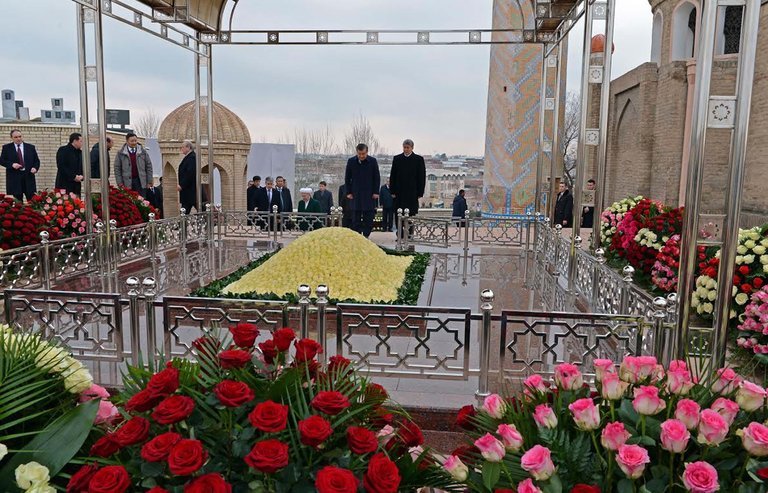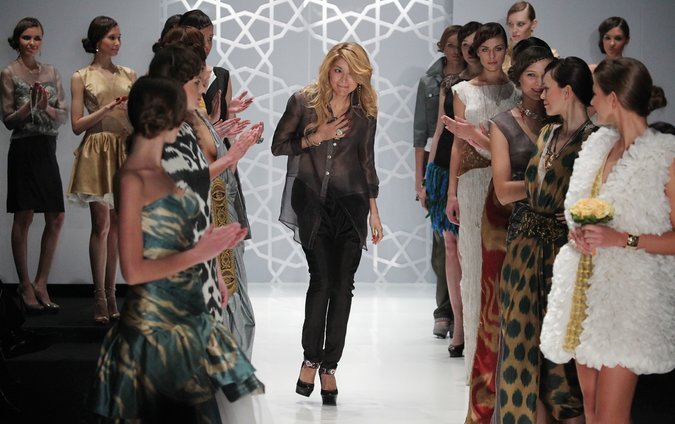 Every five to 10 minutes, from 7 a.m. to 7 p.m. seven days a week, a fresh group of Uzbek pilgrims troops into the tomb of their late president, the dictator Islam Karimov, to pay homage at his white onyx sarcophagus, and listen to prayers chanted in his honor.
Every five to 10 minutes, from 7 a.m. to 7 p.m. seven days a week, a fresh group of Uzbek pilgrims troops into the tomb of their late president, the dictator Islam Karimov, to pay homage at his white onyx sarcophagus, and listen to prayers chanted in his honor.
At this point, more than a year after the bejeweled memorial complex to Mr. Karimov opened, one of the few Uzbeks who has not visited is the woman who until recently was Uzbekistan’s most famous person: his eldest daughter, Gulnara Karimova, 45, who was once talked of as his heir apparent.
Ms. Karimova was also the only family member not to appear at her father’s funeral in 2016 — or at any of the more than 35,000 prayer vigils held since. In fact, since 2014, she has disappeared from public view.
Many visitors to her father’s shrine are on their second or even third pilgrimage. Schoolchildren come in groups. Newlyweds make it their first honeymoon stop, conveniently adjacent to the 15th-century Registan Square monuments, among Central Asia’s most magnificent architectural treasures.
Even political prisoners released in the mild “Uzbek spring” that has come after Mr. Karimov’s death have been obliged to pay homage, with a two-day visit to the mausoleum complex as a condition of their freedom.
While the rest of the world saw Islam Karimov as one of the most repressive rulers to emerge from the breakup of the Soviet Union, to many Uzbeks the Soviet-era Communist leader became the father of their nation, who led the country to independence and then fended off the Russian domination that plagued its other neighbors in Central Asia.
That adulation has not, however, rubbed off on Mr. Karimov’s missing first daughter. “Personally, she’s not that interesting to us,” said Maksud Khatamov, who came to visit the mausoleum along with 11 family members, including his four grandchildren. “And she’s not even that pretty.”
Ms. Karimova and her legions of social media admirers would once have protested that — or worse. In her heyday Ms. Karimova was a ruthless businesswoman, diplomat (as ambassador to Spain), Harvard student, mother, socialite and, in the words of an American Embassy cable unearthed by WikiLeaks, a “robber baron” who seized companies from others on a whim, her father’s power making her untouchable.
She was also a fashion designer with her own line, Guli, and a singer, making pop music videos with the stage name Googoosha.
“This is a woman who could not get enough attention and was everywhere, and no word from her since 2014,” said Steve Swerdlow, a Human Rights Watch researcher for Central Asia, who said he found himself in the unusual position of being approached by family members of the dictator’s daughter for help in finding out what happened to her.
Googoosha - How Dare (Official Video) Video by RealGoogoosha
Many think “Googoosha” is dead, and there is no proof to the contrary. “We heard she died maybe,” said Islamova Nilofar, 20, who was visiting the dictator’s mausoleum with her two sisters. “There hasn’t been one bit of information,” said one sister, Zarina Odilova, 25. “She didn’t come here, that’s for sure.”
Last July the new government of President Shavkat Mirziyoyev, who had been Mr. Karimov’s prime minister, briefly broke its silence on Ms. Karimova.

Gulnara Karimova, center, after a 2011 show of her fashion brand in Moscow. Sergei Ilnitsky/EPA, via Shutterstock
The prosecutor general’s office in Tashkent, the capital, announced that she had been convicted of tax evasion, extortion “of money and stakes in large Uzbek companies” and theft of state property, and sentenced to five years of “restricted liberty.”
There was no explanation of what that meant, but presumably it is a form of house arrest. She remained in jail, though, the statement added; she was being held on another criminal charge while the authorities sought to recover more than $1.62 billion in stolen assets abroad.
The prosecutor general’s office did not respond last week to a written request for information on the status of her case. Other government officials said they could not discuss her case or that of one of her top lieutenants, Gayane Avakyan, who is also imprisoned.
Most Uzbeks visiting her father’s grave seem to want to forget about Ms. Karimova, and many nervously refuse to discuss the former first daughter at all.
“Maybe she had some trouble with serious people and maybe they didn’t allow her to come here, we don’t know,” said Jamshid Ayubjanov, 28, a restaurateur from the Fergana Valley who was on his second visit to the mausoleum. He changed the subject. “There was never such a president as our late president,” he said.
Long before Ms. Karimova’s formal fall from grace, there were signs that her glamour and celebrity friends could no longer protect her. Her dictator father reportedly beat her up in a family spat in 2013, and Ms. Karimova publicly accused her mother and younger sister, Lola, of witchcraft, among other things. (Lola Karimova-Tillyaeva has troubles of her own, apparently, and recently resigned from her ambassadorship to Unesco.)
Then Ms. Karimova’s once-active Twitter account was shut down. She was refused permission for her Guli brand to attend New York fashion shows because the clothing used Uzbek cotton, produced with slave labor. Even the beauty that she often boasted of seemed to desert her, as she resorted to increasing doses of Botox. Then came her 2014 arrest, with what family members claim is no access to relatives or lawyers ever since.
Mr. Swerdlow of Human Rights Watch said he had even heard from her ex-husband, Mansur Maqsudi, who wanted to find out what has happened to her, which was itself surprising.
Mr. Maqsudi, an American of Uzbek and Afghan origin who lives in New York, was in an acrimonious divorce and custody battle in 2002 with Ms. Karimova, when she was still powerful. He lost his Coca-Cola business in Uzbekistan and saw all 24 of his relatives who lived in Uzbekistan deported to Afghanistan, regardless of citizenship; at least two others were jailed.
None of the visitors to Mr. Karimov’s mausoleum seemed concerned about her fate. “On Gulnara Karimova we have no information and no interest in any information,” said Mamura Abdurahmova, 34. “On Islam Karimov, not since Tamerlane have we had someone so great.”
Mr. Karimov’s tomb, while grand, is not as spectacular as some of the towering, mosaicized monuments in Samarkand from the great Uzbek emperor Tamerlane’s era. But it is nearby and conspicuously connected by a grand promenade and a bridge to the Registan, that is now called Islam Karimov Avenue. It was once named after Tamerlane.
Ms. Karimova’s son, named Islam after his grandfather, is applying for asylum in Britain, where he lived as a college student, and has complained that his mother is being held incommunicado, without even legal representation.
“I don’t understand how in the 21st century they cannot answer a simple question,” he said in a BBC interview. “Where is Gulnara?”
The New York Times, APRIL 4, 2018




